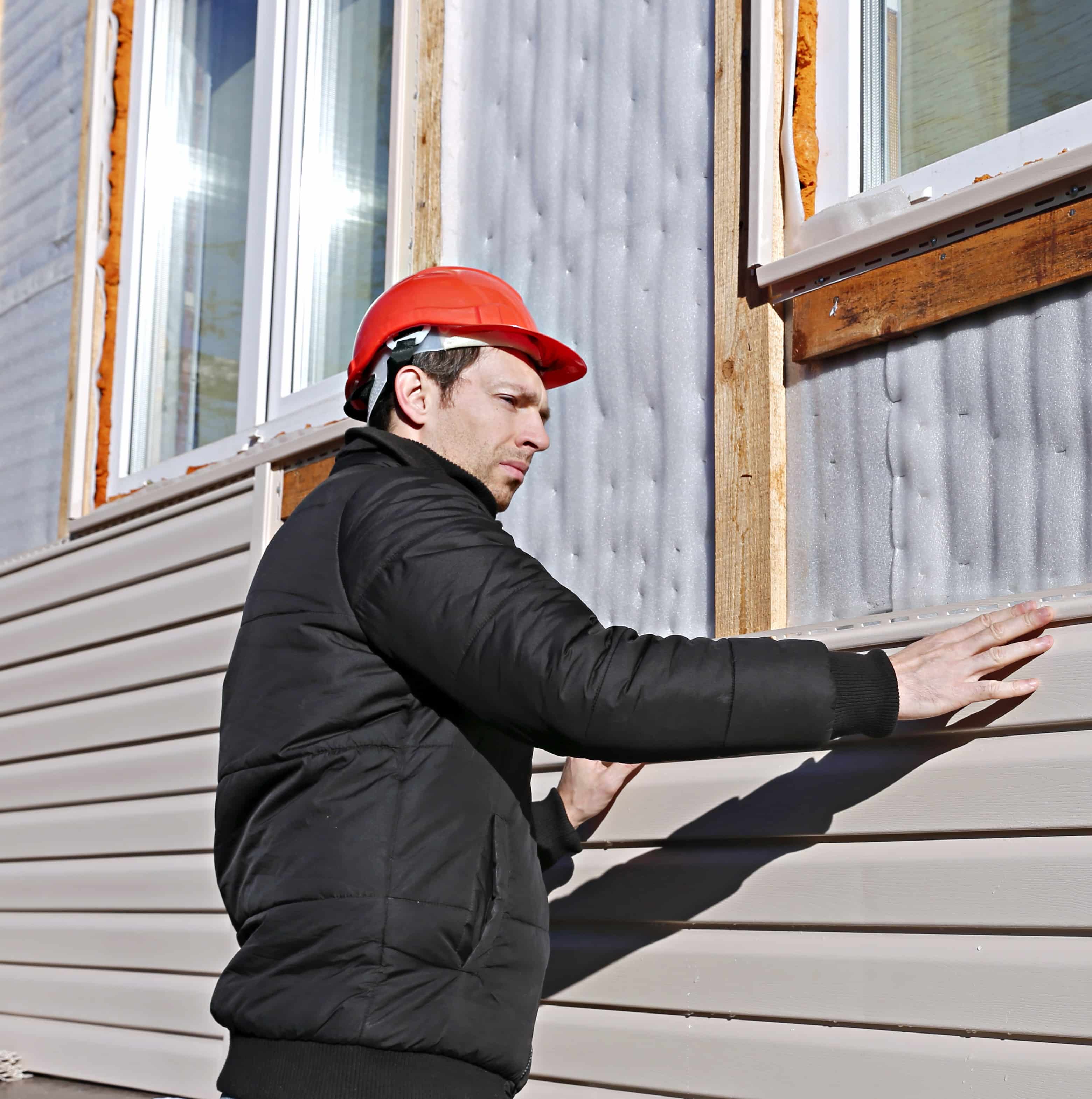







Simply enter the service you need, and your details then press "Spetz-it".
You'll be connected immediately to a nearby top-rated service provider.
Your rating is important. So you can help other customers get the best specialist too.
Hiring the best siding installation service near you in the United Kingdom involves careful research, assessment, and consideration of various factors. Here are steps to help you find and hire the right siding installation professional:
1. Define Your Siding Needs:
– Clearly define the scope of your siding project. Identify the type of siding material you want (e.g., vinyl, wood, fibre cement) and any specific design preferences.
2. Research Local Siding Installers:
– Use online resources, directories, and recommendations from friends, family, or neighbours to create a list of potential siding installers in your local area.
3. Check Qualifications:
– Verify the qualifications of potential siding installers. Check for licenses, certifications, and memberships in professional associations.
4. Read Reviews and Testimonials:
– Read reviews and testimonials from previous clients to gauge the reputation and quality of work of each siding installer. Online review platforms and the installer’s website can provide valuable insights.
5. Ask for Recommendations:
– Seek recommendations from people in your community who have recently had siding installed. Personal referrals can be valuable in finding reliable installers.
6. View Previous Projects:
– Ask potential installers for a portfolio of their previous siding projects. This allows you to see the quality of their work and assess if they can meet your aesthetic preferences.
7. Licensing and Insurance:
– Ensure that the siding installer is licensed and carries the necessary insurance, including liability and workers’ compensation. This protects you from potential liabilities during the project.
8. Get Multiple Quotes:
– Obtain detailed quotes from multiple siding installers. Compare the quotes, considering the type of siding material, labour costs, and any additional services included.
9. Check for Specialization:
– Confirm that the installer specializes in the type of siding material you prefer. Different materials may require specific expertise and skills.
10. In-Person Consultation:
– Schedule in-person consultations with the shortlisted installers. This allows you to discuss your project in detail, ask questions, and get a feel for their professionalism.
11. Ask About the Installation Process:
– Inquire about the installation process, including the steps they will take, the timeline for completion, and any potential disruptions to your daily routine.
12. Check for Warranties and Guarantees:
– Ask about the warranties or guarantees offered by the installer. A reputable installer should provide assurances about the quality of their work.
13. Evaluate Communication:
– Assess the communication style of the installer. Choose someone who communicates clearly, is responsive to your inquiries, and provides updates throughout the project.
14. Verify Permits and Compliance:
– Ensure that the siding installer will obtain any necessary permits for the project and complies with local building codes.
15. Consider Energy Efficiency:
– If energy efficiency is a priority, discuss options for insulated siding materials and inquire about the installer’s expertise in this area.
16. Discuss Cleanup and Disposal:
– Inquire about the cleanup process after the installation and how disposal of old siding materials will be handled.
17. Payment Structure:
– Discuss the payment structure. Be cautious of installers who require a large upfront payment. A reasonable payment schedule tied to project milestones is common.
18. Ask About Maintenance Tips:
– Inquire about maintenance tips for the specific type of siding material you choose. A reputable installer should provide guidance on how to care for and maintain the siding.
19. Check References:
– Ask for references from recent clients. Contact these references to get firsthand feedback on their experience with the siding installer.
20. Trust Your Instincts:
– Trust your instincts when selecting a siding installer. Choose someone who instills confidence, is transparent in communication, and aligns with your vision for the project.
By following these steps, you can hire a siding installation professional who meets your specific requirements and ensures a successful and satisfactory project outcome.
Siding installation involves the process of attaching exterior cladding or siding materials to the walls of a building, primarily for protection and aesthetic purposes. Siding serves as a protective layer that shields the underlying structure from the elements, enhances energy efficiency, and contributes to the overall appearance of the property. In the United Kingdom, as in many other regions, siding installation is a common practice to improve the durability and curb appeal of homes and commercial buildings.
What Siding Installation Entails:
1. Material Selection:
– Siding installation professionals help clients choose suitable siding materials based on factors such as climate, architectural style, and personal preferences. Common siding materials include vinyl, wood, fibre cement, metal, and composite materials.
2. Measurement and Estimation:
– Accurate measurements of the building are taken to estimate the amount of siding material required. This involves calculating the square footage of walls, accounting for windows, doors, and other openings.
3. Preparation of Exterior Walls:
– Before installation, the exterior walls must be prepared. This may involve cleaning, repairing any existing damage, and applying a moisture barrier or insulation, depending on the type of siding and local building codes.
4. Installation Process:
– The actual installation process varies depending on the type of siding material chosen. Common methods include nailing, stapling, or fastening the siding to the exterior walls. Installers ensure proper alignment, spacing, and secure attachment for a durable and aesthetically pleasing finish.
5. Trim and Detail Work:
– Siding installation includes the addition of trim pieces around windows, doors, corners, and other architectural features. This trim provides a finished look and helps to seal edges against moisture.
6. Sealing and Weatherproofing:
– Proper sealing and weatherproofing are crucial to prevent water infiltration and ensure the longevity of the siding. Installers use appropriate sealants, flashing, and caulking to create a weather-resistant barrier.
7. Insulation Considerations:
– Some siding materials, such as insulated vinyl or fibre cement with added insulation, contribute to the building’s energy efficiency. Installers may incorporate insulation during the siding installation process.
8. Cleanup and Disposal:
– After the installation is complete, professionals clean up the work area, removing any debris and leftover materials. Proper disposal of old siding materials is also part of the cleanup process.
What Siding Installation Professionals Can Do:
1. Residential Siding Installation:
– Siding professionals work on homes, installing siding materials to enhance aesthetics, protect against the elements, and improve energy efficiency.
2. Commercial Siding Installation:
– Commercial buildings also benefit from siding installation, providing protection and a polished appearance for businesses and other commercial properties.
3. Siding Replacement:
– Professionals can replace old or damaged siding with new, more durable materials, refreshing the look of a property and addressing structural concerns.
4. Siding Repair:
– Repair services may include fixing damaged sections of siding, addressing issues such as cracks, warping, or loose panels.
5. Custom Siding Designs:
– Siding installation professionals can work with clients to create custom designs, incorporating unique patterns, textures, or colour combinations.
6. Advice on Material Selection:
– Professionals offer guidance on selecting the most suitable siding materials based on the client’s preferences, budget, and the local climate.
7. Weatherproofing and Insulation:
– Siding installers ensure that the siding is properly sealed and weatherproofed, contributing to the building’s insulation and energy efficiency.
8. Maintenance Tips:
– Professionals may provide clients with advice on how to maintain and care for their siding, preserving its appearance and functionality over time.
Siding installation is a comprehensive process that requires expertise in construction, attention to detail, and knowledge of various siding materials. Hiring a qualified siding installation professional is essential to ensure a successful and durable outcome for your property.
Siding installation professionals in the United Kingdom can assist with a range of jobs related to the installation, replacement, repair, and maintenance of siding on residential and commercial buildings. Here are some specific jobs that siding installation specialists can help with:
1. New Siding Installation:
– Installing siding on new construction projects, providing a protective and aesthetically pleasing exterior.
2. Siding Replacement:
– Removing and replacing old or damaged siding with new materials to improve the building’s appearance and durability.
3. Siding Repair:
– Addressing issues such as cracks, warping, loose panels, or other damage to restore the functionality and appearance of the siding.
4. Material Selection and Consultation:
– Assisting clients in choosing the most suitable siding materials based on their preferences, budget, and the local climate.
5. Weatherproofing and Insulation:
– Ensuring proper weatherproofing by sealing joints, corners, and edges to protect against moisture infiltration. Some siding materials also contribute to insulation.
6. Trim and Detail Work:
– Adding trim pieces around windows, doors, corners, and other architectural features to provide a finished and polished look.
7. Custom Siding Designs:
– Collaborating with clients to create custom siding designs, incorporating unique patterns, textures, or colour combinations.
8. Commercial Siding Installation:
– Installing siding on commercial buildings, contributing to the aesthetics and protection of businesses and other commercial properties.
9. Residential Siding Installation:
– Working on residential properties to install siding materials that enhance curb appeal, protect against the elements, and improve energy efficiency.
10. Insulated Siding Installation:
– Installing siding materials with added insulation to improve energy efficiency and thermal performance.
11. Siding Maintenance Tips:
– Providing clients with advice on how to properly maintain and care for their siding, preserving its appearance and functionality over time.
12. Cleanup and Disposal:
– Conducting cleanup after the installation or repair process, removing debris, and ensuring proper disposal of old siding materials.
13. Consultation on Building Codes:
– Advising clients on compliance with local building codes and obtaining necessary permits for siding projects.
14. Advice on Upgrades:
– Offering recommendations for upgrades or enhancements to existing siding, such as additional weatherproofing measures or the integration of new technologies.
15. Colour and Style Consultation:
– Assisting clients in choosing siding colours and styles that complement the architectural design and overall aesthetic of the property.
16. Siding Inspection:
– Conducting inspections of existing siding to assess its condition, identify issues, and recommend appropriate solutions.
17. Emergency Repairs:
– Providing emergency repairs in the case of sudden damage to siding, such as storm or impact damage.
18. Warranty and Guarantee Services:
– Offering warranties or guarantees on the work performed, ensuring the quality and durability of the siding installation.
Siding installation professionals play a crucial role in improving the functionality, durability, and visual appeal of buildings. Whether it’s a new installation, replacement, repair, or maintenance, these specialists contribute to the overall well-being and aesthetics of residential and commercial properties in the United Kingdom.
The cost of siding installation in the United Kingdom can vary widely based on several factors, including the type of siding material, the size of the project, the complexity of the installation, and regional labour and material costs. Additionally, factors such as the condition of existing walls, the need for insulation, and any customization or trim work can influence the overall cost. Here are some general considerations:
1. Type of Siding Material:
– The choice of siding material significantly impacts the cost. Common siding materials include vinyl, wood, fibre cement, metal, and composite materials. Each material has its own price range.
2. Size of the Project:
– The total square footage of the building or area that requires siding affects the overall cost. Larger projects generally incur higher costs due to increased material and labour requirements.
3. Labour Costs:
– Labour costs for siding installation include the wages of the installation crew. Skilled labour may come at a higher cost, especially if the installation requires special skills or customization.
4. Additional Services:
– If insulation or weatherproofing measures are included in the project, this can add to the overall cost. Trim work, customization, or special designs may also incur additional charges.
5. Condition of Existing Walls:
– If there are repairs or preparation work needed on the existing walls before siding installation, this can contribute to the overall cost.
6. Location:
– Regional variations in labour and material costs can influence the overall cost of siding installation. Urban areas or regions with higher living expenses may have higher service fees.
7. Type of Installation:
– The method of installation, such as whether the siding is nailed, stapled, or fastened using a specific technique, can affect the labour costs.
8. Customization and Design:
– Customized designs, patterns, or colour variations may increase the overall cost of siding installation.
9. Trim and Detail Work:
– Adding trim around windows, doors, corners, and other architectural features may come with additional costs.
10. Warranties and Guarantees:
– If the siding material or installation service comes with extended warranties or guarantees, it may impact the overall cost.
To get an accurate estimate for siding installation, it’s recommended to obtain quotes from multiple siding installation professionals. A detailed quote should include the cost of materials, labour, any additional services, and a breakdown of expenses. Additionally, inquire about payment schedules, financing options, and any available warranties or guarantees. While cost is an important factor, it’s equally crucial to consider the reputation and experience of the siding installation professional to ensure a quality installation that meets your specific needs.
When hiring a local siding installation professional in the United Kingdom, asking the right questions is essential to ensure that you choose a reputable and qualified contractor. Here are some key questions to ask:
General Questions:
1. Are you licensed and insured to operate as a siding installation professional in this area?
– Verify that the contractor has the necessary licenses and insurance coverage.
2. How long have you been in the siding installation business?
– Inquire about the contractor’s experience to assess their expertise in siding installation.
3. Can you provide references or examples of past siding installation projects you’ve completed?
– Request references or view a portfolio of completed projects to gauge the quality of their work.
Project-Specific Questions:
4. What siding materials do you specialize in installing?
– Ensure that the contractor is experienced with the type of siding material you plan to use (vinyl, wood, fibre cement, etc.).
5. Can you provide a detailed written estimate for the entire siding installation project, including materials and labour?
– Obtain a comprehensive written estimate that outlines all costs associated with the project.
6. What is the expected timeline for completing the siding installation project?
– Discuss the estimated timeline to ensure it aligns with your expectations and any potential deadlines.
7. Do you offer different siding styles and colours for customization?
– Inquire about the availability of various siding styles and colours to suit your preferences.
8. How do you approach weatherproofing and insulation during the siding installation process?
– Discuss the methods and materials the contractor uses to ensure proper weatherproofing and insulation.
Installation Process and Techniques:
9. What is your preferred method of siding installation (nail-down, stapling, etc.)?
– Understand the installation methods the contractor uses and why they prefer them.
10. How do you handle corners, joints, and edges to ensure a weather-resistant seal?
– Inquire about the techniques used to create a weather-resistant barrier around corners, joints, and edges.
Cleanup and Disposal:
11. What is your process for cleanup after the siding installation is complete?
– Discuss how the contractor plans to clean up the work area and dispose of any debris or old siding materials.
Payment and Contracts:
12. What is your payment structure, and are there any additional fees I should be aware of?
– Discuss the payment schedule and inquire about any potential additional fees.
13. Can you provide a contract that outlines the scope of work, materials, costs, and timeline?
– Ensure that all aspects of the project are documented in a detailed contract.
Warranties and Guarantees:
14. Do you offer any warranties or guarantees on your siding installation work, and what do they cover?
– Understand the warranty or guarantee provided for the installation work.
Compliance and Permits:
15. How do you ensure compliance with local building codes, and will you obtain the necessary permits for the project?
– Discuss the contractor’s approach to compliance with local regulations and obtaining permits.
Emergency Repairs:
16. Do you provide emergency siding repair services in case of sudden damage (storm, impact, etc.)?
– Inquire about the availability of emergency repair services.
Communication:
17. How will we communicate throughout the siding installation project, and is there a designated point of contact?
– Establish expectations for communication and inquire about a designated point of contact.
18. How do you handle changes or unexpected issues during the project?
– Discuss the contractor’s approach to addressing changes or unexpected issues that may arise.
By asking these questions, you can gather important information to make an informed decision when selecting a siding installation professional for your project. It’s crucial to choose a contractor who not only provides a competitive quote but also demonstrates professionalism, experience, and a commitment to quality workmanship.